
By Hanxie & Jiangyu
What is the value of Serverless and low code when they intersect in the same business? This article uses blind box lottery, a creative marketing activity done by Serverless Devs, as an example. It aims to tell how Serverless and low code are matched to meet the business demand.
Online H5 creative animation combined with offline entity rewards is a common means of Internet marketing activities. The cycle from planning to the landing of activities is short to grasp the key time nodes. Landing online services in a short period poses a big challenge to those who do technology development.
The challenge is often doubled, especially when there are many requirements, such as adding background management and key frontend access data tracking points. For development, in addition to completing the core business demands, it is often necessary to pay attention to other situations other than non-business demands. They include system access security, high concurrent traffic response, and observable system operation indicators.
In the past, such requirements often involved many roles, such as product, frontend, backend, design, testing, and operation and maintenance. It makes the input-output ratio low and the activity continuity poor. Today, we can reduce the cost of doing such activities and make them continuous using Serverless + low code technology, thus improving the operation effect.
Serverless Devs only invested 3.5 people in this blind box lottery. It completed the activity planning, product design, front and backend implementation, system deployment and operation and maintenance, etc. These non-business challenges (such as system access security, high concurrent traffic, and system observability) are easily met with the help of Serverless service capabilities. The completion of functionality and the improvement of efficiency have enabled this operation to achieve more. The templated precipitation of activity services has laid a good foundation for subsequent similar activities.
The following is the overall process of the blind box lottery:
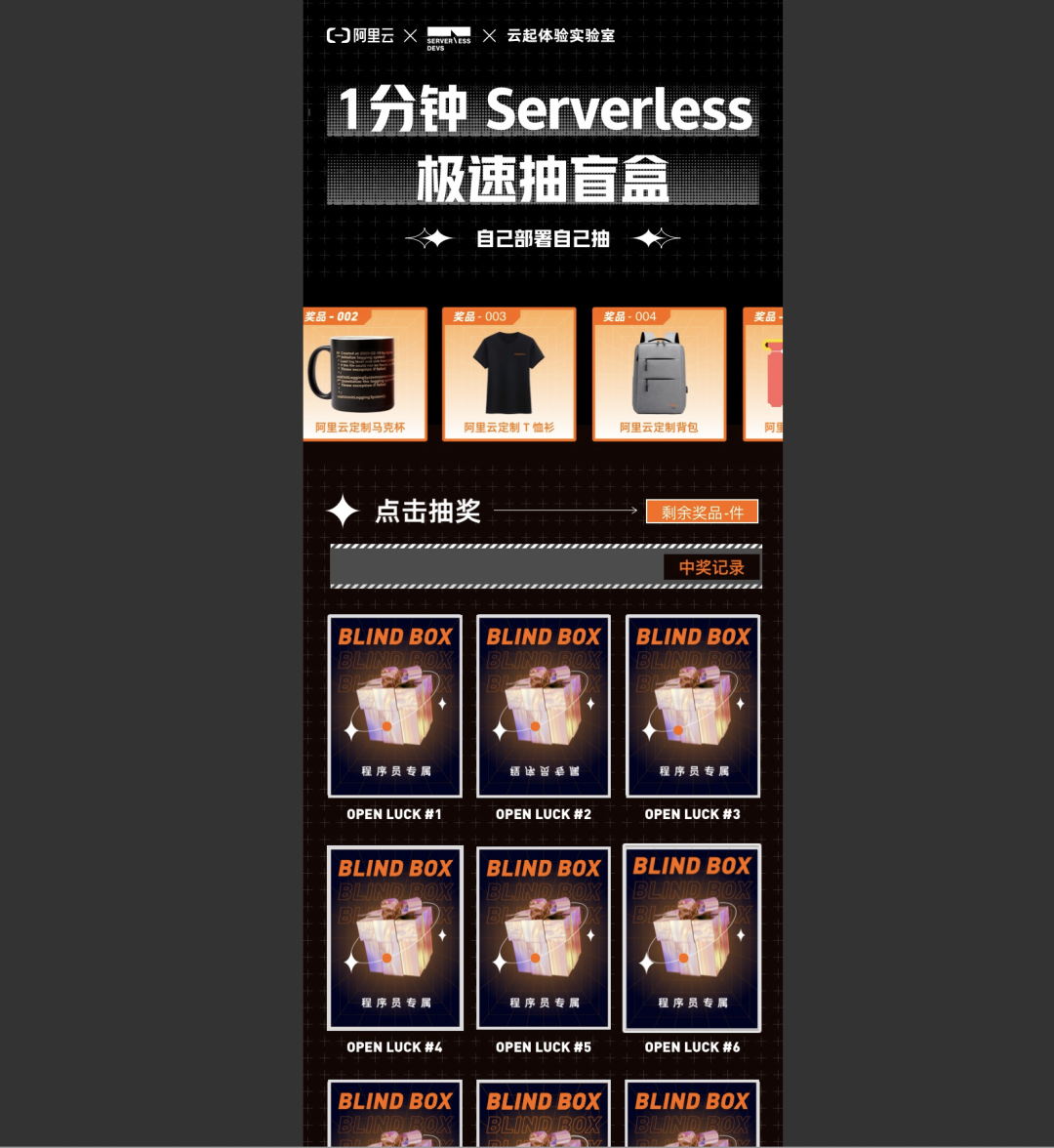
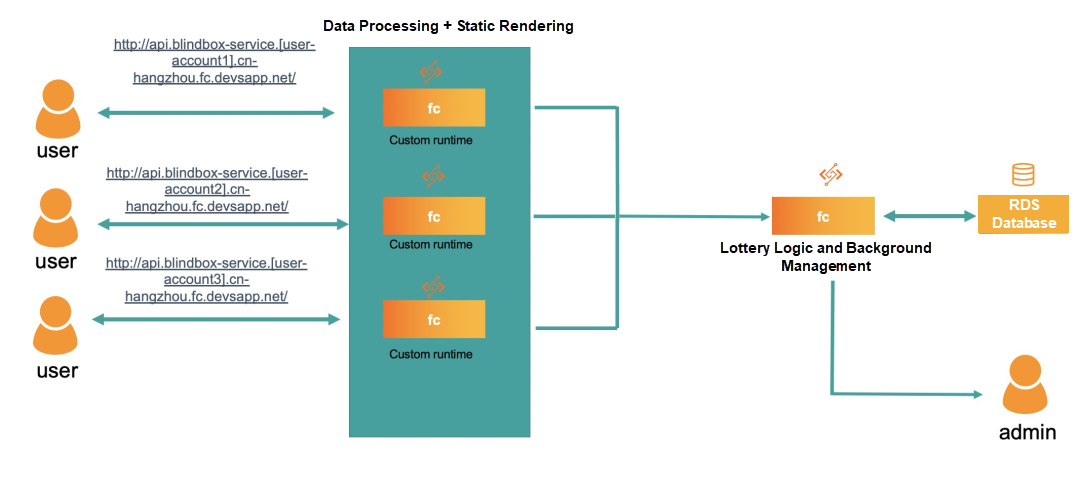
This deployment architecture does not use Alibaba Cloud API Gateway but uses the Function Compute Custom Runtime as the hosting form. It is because of the particularity of this requirement. We deploy our own, which means the end-side access is decentralized, and the end-side access services are thin. Only the data processing interface calls and provides static rendering services. After that, a centralized logical background processes the winning probability and manages the prize query database.
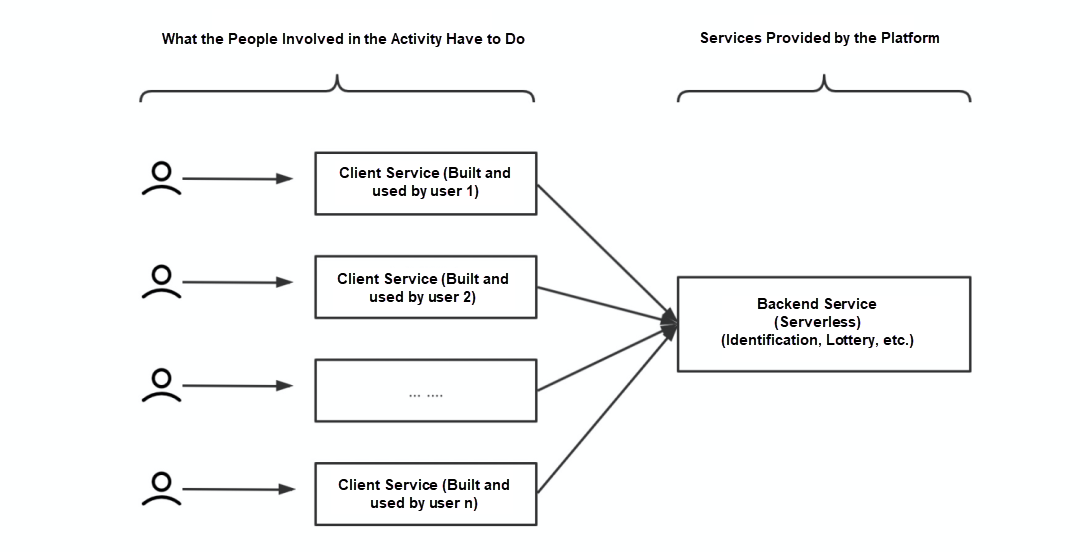
If you design the centralized activity background, it is recommended to refer to the following architecture mode. You can use API Gateway as the traffic entrance to facilitate more security restrictions and flexible expansion.
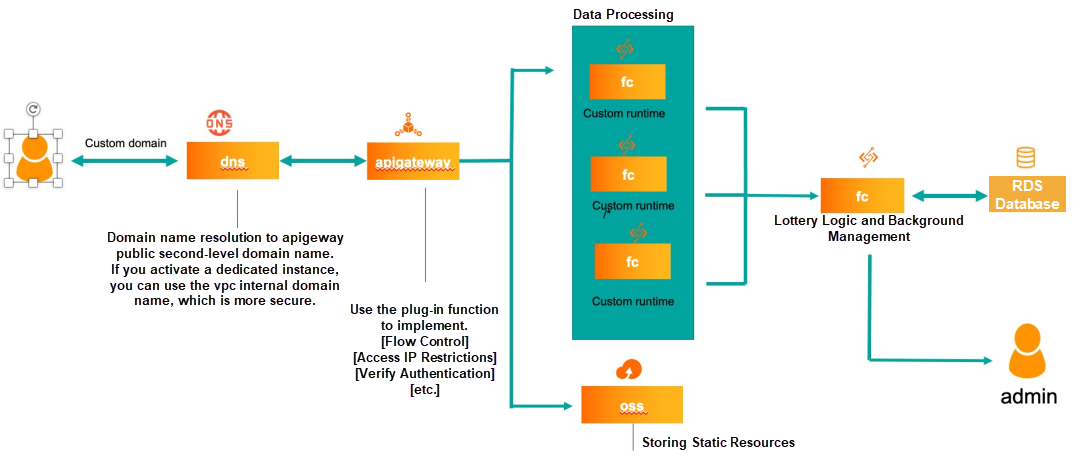
This frontend implementation uses low code to work hype4. The specific use of hype4 will not be described in detail here. You can search for it if interested.
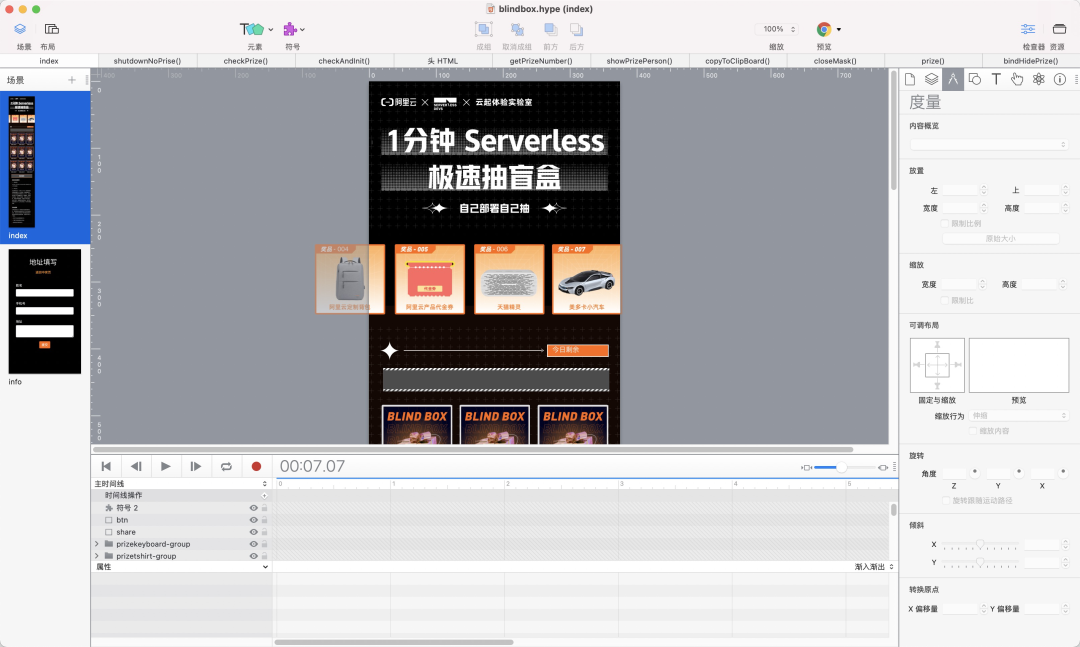
In addition to cutting out the required drawings, the design draft realizes the animation effect just like processing Flash. Finally, js code is added to realize the capabilities of interface access and scene switching. The whole process will be faster than full coding, especially when the dynamic effect is 2-3 times more efficient than pure handwriting.
As shown in the architecture, the data layer here is SSF. This layer only does data forwarding and static rendering. The code implementation is simple. It uses the express framework and deploys it as a Function Compute Custom Runtime.
The purpose is to host both static content and dynamic data forwarding. Note: The information acquisition of users is also realized at this level.
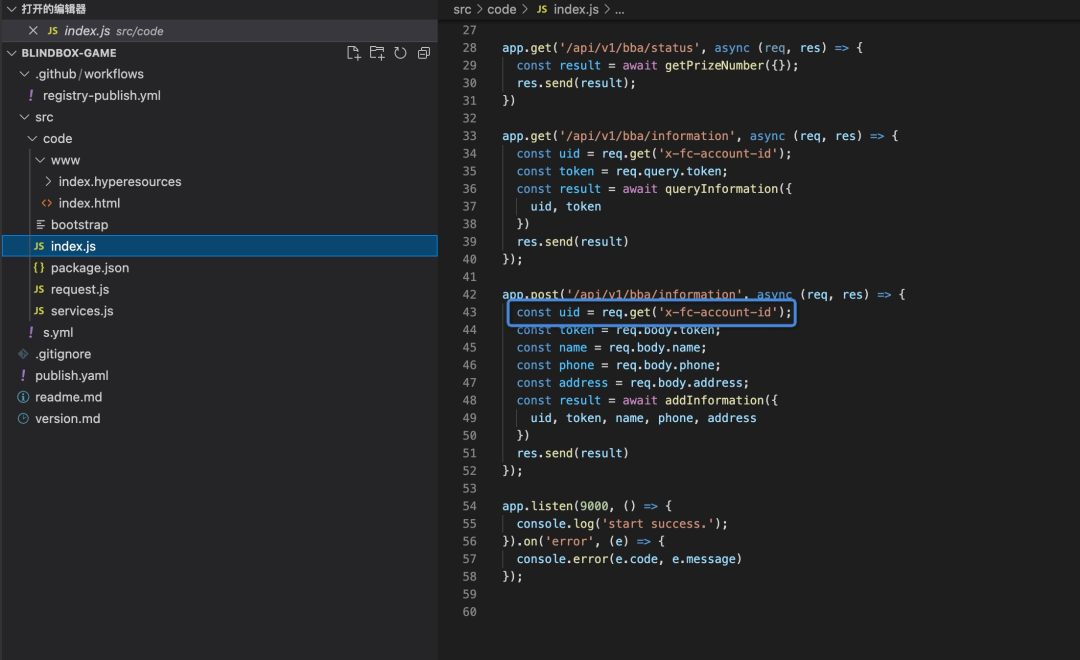
Here, we obtain the accountId of Alibaba Cloud users, which is convenient to align the winning information and distribute prizes. This parameter does not make much sense to ordinary developers.
We will deploy the lottery background in advance. Next, after each user has deployed this layer of services, they will access the deployed services and pass basic information (such as uid) to the lottery background to launch the lottery. The final result is passed to the frontend display. As an administrator, you can set prizes and probabilities through background operations.
The backend service is implemented with the Python Web framework: Django. The main methods are:

1. The user deploys the client service of the blind box lottery locally and deploys it to his account through the Serverless Devs developer tool.
You need to issue a temporary domain name to the user during the deployment period. (This temporary domain name requires the uid of users.) Serverless Devs generates some client tokens during the temporary domain name issuance process. It is recorded in the Serverless Devs backend service. This token is an important mark for identifying users.
(If users declare in YAML that they do not use the domain name information issued by the system, they may not be able to participate in this activity.)
2. After the user is deployed, a temporary domain name issued by Serverless Devs is returned for users to learn and test.
3. Next, you can open the temporary domain name through your browser to see the relevant page of the lottery. Users can click to participate in the lottery.
4. After clicking, the user will initiate a request for Serverless service under the user account. The service will process the user's uid information and initiate a real lottery request to the backend Serverless service of this activity.
5. When the backend Serverless service of this activity receives the lottery request from the user, it will:
It makes a preliminary evaluation of the current system in the process of lottery operation. A simple and easy lottery function that can be used for small-scale lottery activities is designed:

This is the Django project implementation method:
@csrf_exempt
def prize(request):
uid = request.POST.get("uid", None)
if not uid:
return JsonResponse({"Error": "Uid is required."})
temp_url = "<The validity of obtaining uid, important judgment basis>?uid=" + str(uid)
if json.loads(urllib.request.urlopen(temp_url).read().decode("utf-8"))["Response"] == '0':
return JsonResponse({"Error": "Uid is required."})
token = randomStr(10)
# Get the prize of the day
prizes = {}
for eve_prize in PrizeModel.objects.filter(date=time.strftime("%Y-%m-%d", time.localtime())):
prizes[eve_prize.name] = {
"count": eve_prize.count,
"rate": eve_prize.rate
}
# Build a lottery pool
prize_list = []
for evePrize, eveInfo in prizes.items():
temp_prize_list = [evePrize, ] * int((100 * eveInfo['rate']))
prize_list = prize_list + temp_prize_list
none_list = [None, ] * (100 - len(prize_list))
prize_list = prize_list + none_list
pre_prize = random.choice(prize_list)
# Data warehousing
try:
UserModel.objects.create(uid=uid,
token=token,
pre_prize=pre_prize,
result=False)
except:
try:
if not UserModel.objects.get(uid=uid).result:
return JsonResponse({"Result": "0"})
except:
pass
return JsonResponse({"Error": "Everyone can only participate once."})
if not pre_prize:
return JsonResponse({"Result": "0"})
user_id = UserModel.objects.get(uid=uid, token=token).id
users_count = UserModel.objects.filter(pre_prize=pre_prize, id__lt=user_id, date=time.strftime("%Y-%m-%d", time.localtime())).count()
# Final judgment of whether to win the prize
if users_count >= prizes.get(pre_prize, {}).get("count", 0):
return JsonResponse({"Result": "0"})
UserModel.objects.filter(uid=uid, token=token).update(result=True)
return JsonResponse({"Result": {
"token": token,
"prize": pre_prize
}})When the user wins the lottery, the system will generate a token. The combination of the token and the uid is an important basis for judging whether the user wins the lottery. There may be a question involved here. Why should a token be added to make the combination judgment when there is a uid?
The reason is simple. The winning information is submitted and queried. If the winning information is processed through uid, it is likely that users will illegally obtain the information submitted by other users through traversal and other means. This part of the information possibly involves the receiving address submitted by the user. Therefore, a token has been added to increase the complexity of being traversed by violence (to a certain extent) and for the sake of safety overall. This part of the method is simple:
@csrf_exempt
def information(request):
uid = request.GET.get("uid", None)
token = request.GET.get("token", None)
if None in [uid, token]:
return JsonResponse({"Error": "Uid and token are required."})
userInfor = UserModel.objects.filter(uid=uid, token=token)
if userInfor.count() == 0:
return JsonResponse({"Error": "No information found yet."})
if not userInfor[0].result:
return JsonResponse({"Error": "No winning information has been found yet."})
if request.method == "GET":
return JsonResponse({
"Result": {
"prize": userInfor[0].pre_prize,
"name": userInfor[0].name,
"phone": userInfor[0].phone,
"address": userInfor[0].address
}
})
elif request.method == "POST":
name = request.POST.get("name", None)
phone = request.POST.get("phone", None)
address = request.POST.get("address", None)
if None in [name, phone, address]:
return JsonResponse({"Error": "Name, phone and address are required."})
userInfor.update(name=name,
phone=phone,
address=address)
return JsonResponse({"Result": "Saved successfully."})
The whole process is:
uid and token of users.Other security-related supplementary instruction:
token? This is not easy to realize on the browser side because the user may change the browser. However, it is easy for the user to realize it in the function service of the Function Compute platform. Therefore, the domain name issuing stage is adopted to record the domain name information issued in the specified period and compare it in the later stage. It issues a temporary domain name and participates in the activity within the specified time to ensure the user does deploy the project through the Serverless Devs developer tool. (If the user has registered multiple Alibaba Cloud accounts, it is allowed to participate in the activity.)This deployment does not require a domain name. You can use the custom domain name generated by Function Compute, but you still need to install the Serverless Devs tool. This time, you only need to activate Function Compute.
Some templates in the background of the lottery are still in preparation. Only the deployment of frontend and data layer services is demonstrated.
Reference: Serverless Devs Alibaba Cloud Secret Key Configuration (please see the end of this article)
Use the Serverless Devs command line tool to execute:
s init blindbox-gameEnter guided operation:
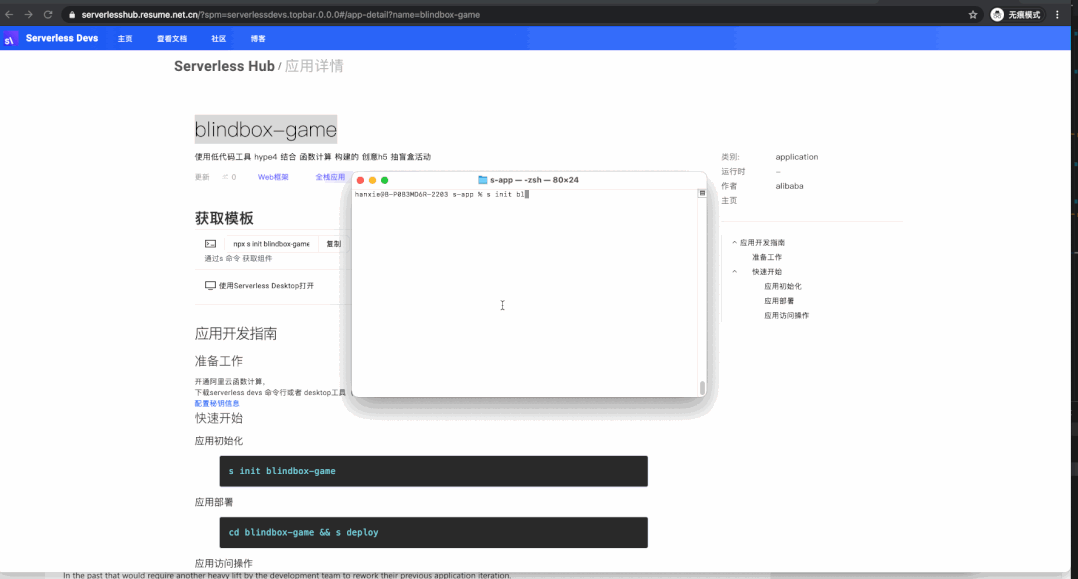
Modify the relevant configuration information and execute the s deploy:
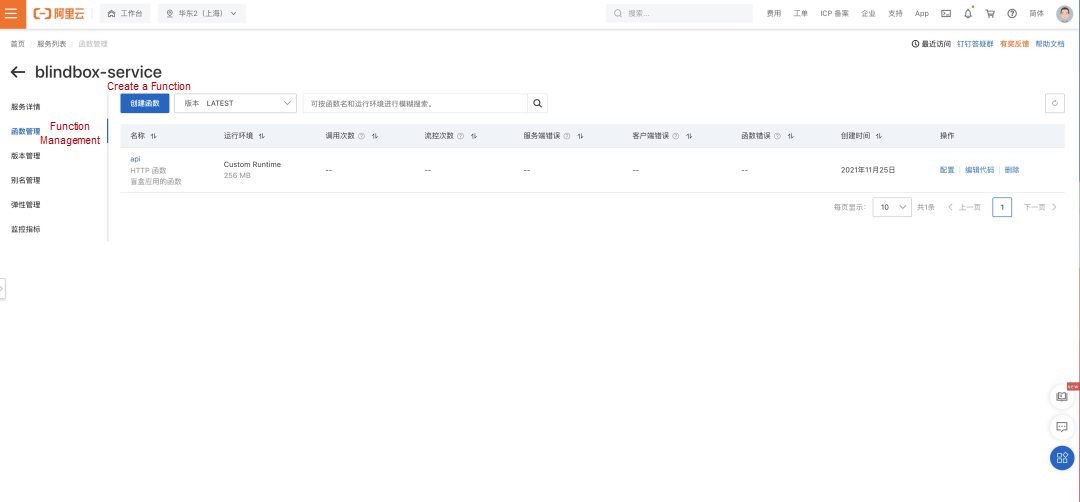
The application template for the lottery is being prepared and will be displayed in this application template.
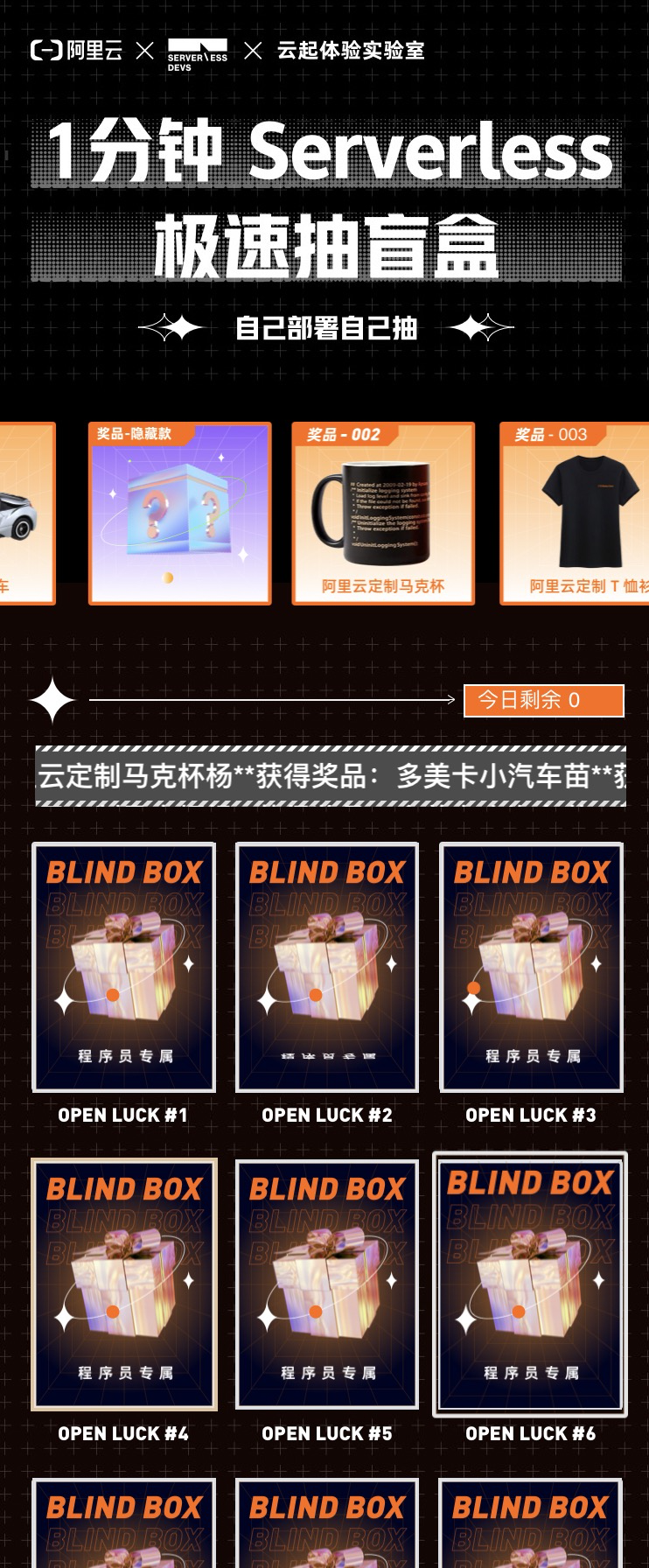
After the practice, I would like to expand the topic of low code and Serverless. The following parts will be mainly theoretical, which will bring different benefits to readers.
As far as I am concerned, the clear conclusion is that I do not reject the compatibility of the two. On the contrary, I hope that the combination of the two can make my work efficient and safe.
My biggest feeling in this activity is that it would be nice if the low code platform could seamlessly connect with Serverless. For example, if I call the interface on low code, it can only be tested after it is built and sent online. This naturally integrated platform has advantages. In addition, it will have to be assembled with the backend interface after the frontend is built. If this is a unified platform, it can be released with one click after the requirements are completed, which will save a lot of trouble. However, there is also a contradiction here. I am worried that once the frontend of the low code is coupled with the backend of Serverless, it will become inflexible and locked by the service provider.
Serverless and low code service providers of cloud service providers are merging. For example, outsystem, a leader in low code platforms, started using AWS services as early as 2016. For example, Lambda provides its customers with the construction of native APP services.
Trillo is a low code platform that uses serverless and model-driven applications as the main service. It is based on the Google cloud service structure to help its users build Serverless services and frontend applications. Various cloud vendors domestically and internationally have done a lot. Azure integrates its low code product Power Apps into Serverless's ability. It forms Serverless Power Apps, fully integrating the advantages of the two.
AWS handed over the integration of the frontend to its partners and focused on Serverless integration on the service side. It launched Step Functions Workflow Studio products to connect Serverless with almost all of its products.
Chinese Tencent has launched a micro-build low code platform, which is the main Serverless + low code platform. It is exerting its power in small program scenarios. The follow-up by various manufacturers shows the importance attached to this field.
The value of Serverless + low code platform is clear. Efficiency, safety, and cost are all keywords. What considerations do we need to make to build such a platform?
First of all, from the platform capability, it should be able to cover all aspects of application development from front to back. For example:
The functional design of this platform can be clarified. It builds corresponding capabilities based on the infrastructure of cloud vendors.
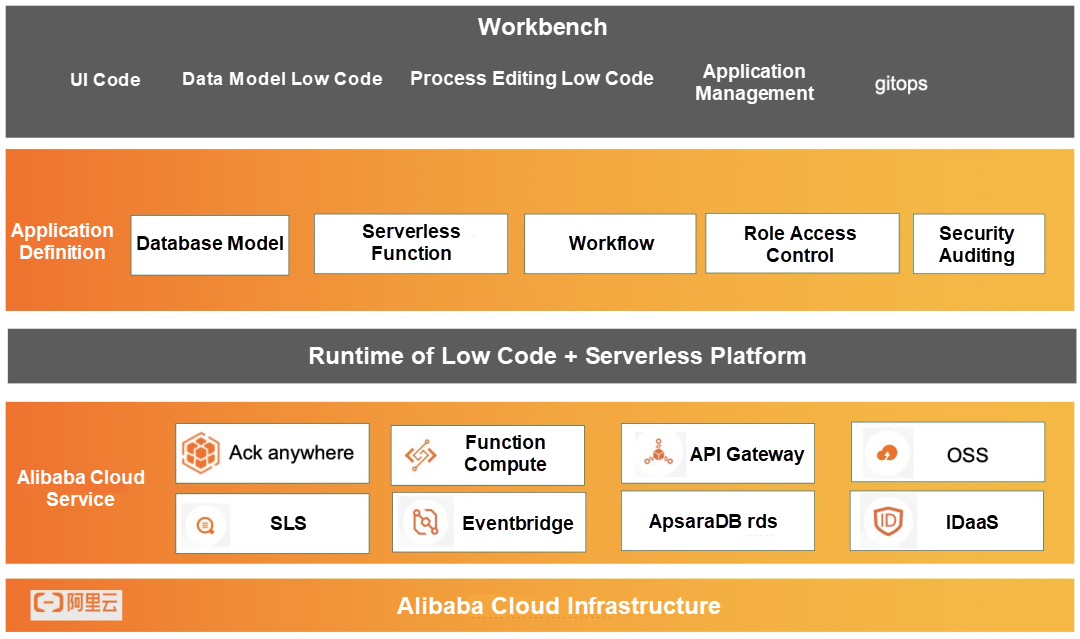
Some open-source products are related to the low code capability, which are listed below:
In addition, you can use the Iac capability of Serverless Devs to connect with cloud infrastructure. The integration with FC is mature, which can manage the full lifecycle of functions.
The sections above are only some of the author's ideas. I know it is not easy to realize such a system. This is intended to be the beginning of it.
Pursuing the improvement of production efficiency has been an important topic in enterprise production. Serverless and low code have an independent division of labor in their respective technical fields, but they share the characteristics of improving production efficiency. It may be important competitiveness for those engaged in the information industry to master and make good use of these two productivity tools at the same time.
Alibaba Cloud API Gateway: https://www.alibabacloud.com/product/api-gateway
Function Compute Custom Runtime: https://www.alibabacloud.com/help/en/function-compute/latest/custom-runtime-overview
Django: https://www.djangoproject.com/
Serverless Devs Alibaba Cloud Secret Key: https://docs.serverless-devs.com/en/serverless-devs/default_provider_config/alibabacloud
How Can You Create a Low Cost, Personal Network Disk with Serverless?
Processing a Cartoon Style Avatar Applet Based on Serverless Architecture
99 posts | 7 followers
FollowFarruh - October 1, 2023
Alibaba Clouder - May 24, 2019
Anna Chat APP - August 28, 2024
Alibaba Cloud Project Hub - March 19, 2024
5793564117225178 - October 12, 2022
Utkarsh Anand - September 9, 2023
99 posts | 7 followers
Follow Digital Marketing Solution
Digital Marketing Solution
Transform your business into a customer-centric brand while keeping marketing campaigns cost effective.
Learn More Web Hosting Solution
Web Hosting Solution
Explore Web Hosting solutions that can power your personal website or empower your online business.
Learn More Architecture and Structure Design
Architecture and Structure Design
Customized infrastructure to ensure high availability, scalability and high-performance
Learn More Web Hosting
Web Hosting
Explore how our Web Hosting solutions help small and medium sized companies power their websites and online businesses.
Learn MoreMore Posts by Alibaba Cloud Serverless